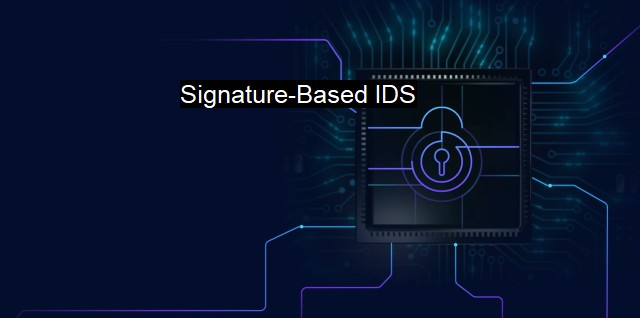What is Signature-Based IDS?
The Importance of Signature-Based Intrusion Detection Systems (IDS) in Cybersecurity: A Pattern-Matching Approach for Malicious Activity Detection and Prevention.
Signature-Based IDS, or Intrusion Detection System, forms a significant element in the cybersecurity paradigm where it functions as a critical tool for detecting threats in a network environment. It is essentially a specialized software that is designed to detect instantly any breached policy or protocol through the use of complex algorithms.This system operates on predefined patterns or 'signatures'. To simplify, a signature-based IDS is like an alarm system that gets triggered when an intruder tries to break into a house or when the established rules are violated in any way. The IDS is mandated to identify and block hostile cyber activity such as malicious software (malware) or security threats like network attacks.
The underlying function of a signature-based IDS lies in its ability to compare incoming traffic behaviour and activity against pre-existing scenarios from a loaded database of known threatening signatures. These signatures include common patterns of harmful activities like viruses, worms, or hacking methods that engage compromised system characteristics or perform unusual activities.
It’s worthy to mention that a signature-based IDS functions heavily on prior knowledge and specification. Because it operates by cross-checking against a database of previously tracked vulnerabilities and threats, it is proficient in blocking major well-known threats. this also leaves the system susceptible to new attacks which cannot be identified by old signatures. This contrastingly becomes the primary limitation of the signature-based IDS since, despite delivering effective detection rates for recognized threats, it’s potentially ineffective in detecting unfamiliar attacks crafted to evade the standard signatures, or what we term as zero-day threats.
To overcome this limitation, security teams frequently update the threat signature profile database; this task is somewhat like a never-ending race. Cyber threats continue to evolve, forcing security teams to persistently instigate novel defenses.
When the signature-based IDS identifies a potential breach, it can act Powerfully, either in an active intrusion detection system model, sending warnings to the system administrators so they can take necessary action, or it can respond passively by simply logging the event or picking up activities that deviate from the norm and report for manual inspection or auto-action.
Notably, signature-based IDS represents an essential security cornerstone to most companies, providing a solid defense line against security loopholes. They don't catch everything on the cyberspace field; their biggest adversaries are unknown threats and rapidly mutating software. their contribution to system security is impactful, protecting companies from major volume of well-known cyber threats.
Signature-based IDS is best applied in conjunction with anomaly-based IDS to provide a comprehensive cybersecurity solution. Anomaly-based IDS identifies intrusions by observing network traffic and detecting strange behaviors, offering an added layer of protection to secure the information highway when the signature-based IDS is unable to detect the attack.
While the signature-based IDS plays a vital role it symbolizes only a patch in the wider framework of the multifaceted and dynamic threat landscape, emphasising that a balanced and comprehensive approach to cybersecurity will be the most efficient strategy in defending against cyberattacks. Despite its limitations, the integration of signature-based IDS into a company’s cybersecurity architecture offers solid, optimized network protection and bolsters the overall security framework. The blend of this IDS'es industry-standard functionalities, combined with other security instruments, thus forms a high-powered prevention system, on guard against cyber threats.

Signature-Based IDS FAQs
What is a signature-based ID in cybersecurity?
A signature-based ID is a method of detecting and preventing malware attacks by comparing the code in suspicious files to a database of known malicious signatures. When a file matches a signature in the database, it triggers an alarm and the antivirus software takes appropriate action to prevent the attack.What are the advantages of using signature-based IDS?
Signature-based IDS has many advantages over other methods of malware detection. They are easy to use, inexpensive, and require minimal resources to maintain. In addition, they are very effective at identifying known threats and can quickly respond to new threats by updating the signature database.What are the disadvantages of using signature-based IDS?
One major disadvantage of using signature-based IDS is that they are only effective against known threats. As soon as a new type of malware is developed, signature-based IDS become useless until a new signature can be added to the database. In addition, attackers often use polymorphic or encrypted code to evade detection by signature-based IDS.How can signature-based IDS be improved?
To improve the effectiveness of signature-based IDS, it is important to regularly update the signature database with the latest threat information. It is also a good idea to use multiple antivirus software programs with different signature databases to increase the chances of detecting new threats. Additionally, security professionals can use behavioral analysis and machine learning to supplement signature-based IDS and detect unconventional malware attacks.| | A | | | B | | | C | | | D | | | E | | | F | | | G | | | H | | | I | | | J | | | K | | | L | | | M | |
| | N | | | O | | | P | | | Q | | | R | | | S | | | T | | | U | | | V | | | W | | | X | | | Y | | | Z | |
| | 1 | | | 2 | | | 3 | | | 4 | | | 7 | | | 8 | | |||||||